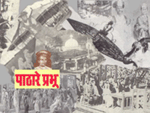|

|
| Pratihaar Prabhus & Shrimant Nanasaheb
Peshwe |
| |
| Pathare Prabhus came from
the regions of Kananj,
Rajputana & Mount Abu. They were probably the descendants of the Pratihars.
The word Pathare is supposed to come from the words 'Parihaar', 'Parihar', 'Pratihaar'
which belong to the Pratihar dynasty. |
| |
| In the first half of the ninth century, the
descendants of Raja Harsha were defeated by the Pratihaar king Nagabhatta
who took over Kananj. The Pratihaar's then ruled Kananj for three generations. During the
reign of Raja Rajpal the great grandson of Nagabhatta, Mohammad of Gazni
attacked and looted Kananj. He slaughtered the Hindus. Pratihaar Prabhus in
order to save their lives fled in all directions. Those Pratihaar Prabhus who
fled to the south took with them their Rajguru Rajshekhar & Yajurvedi
Brahmins. Further migrations took place when Mohammad Ghori attacked and
completely destroyed Kananj in the eleventh & twelfth century. The Prabhus
who migrated came to Paithan in South India and settled under the rule of the
Yadava's. They brought along with them their spiritual leaders Hemaadri &
Krishna who were Yajurvedi Brahmins. |
| |
| The Muslim kingdom prospered in the 14th
century. Under their rule, the Patihar Prabhus and their Rajguru families enjoyed a
glorious time. The Yajurvedi Brahmins performed all the rituals of the Pratihaar
Prabhus (Even today Yajurvedi brahmins perform most
of our religious ceremonies). But the local Chakravarti Rigvedi Brahmins objected saying that
it was only their right to perform the thread & religious ceremonies. Hence there was a ban on religious ceremonies of
the Pratihaar Prabhus. The then Nawab Chand Khan took the side of Pratihaar
Prabhus and ordered that all rituals of
the Pratihaar Prabhus must be performed by Yajurvedi Brahmins. This proves that
Pratihaar Prabhus are Kshatriyas since they performed thread ceremonies. |
| |
| The Seventeenth century was taxing for
the Hindus. The Portuguese had started their oppressive rule in
India. They stopped all religious rituals (Kirtans, Pravachans, etc). Each and every house was
ransacked and idols of all Hindu Gods and Goddess were destroyed. Hindu property
was taken away and they were given death sentences. The Jahagir in Malad of
Antaji Raghunath who was the rajguru of Raja Bimbadev and also the
spiritual leader of the locals in Vasai, was taken forcibly by the
Portuguese. They also
converted many Hindus. Hence these harassed Pratihar Pathare Vasaikar's and
other Hindus helped the Peshwas who were under the leadership of Chimaji
Appa attacked the Fort of Vasai in 1739-40. Pathare Prabhu Khanduji
Mankar and their Yajurvedi Brahmin Antaji are the notable names in this war. The
Peshwas promised Antaji the jahagir of Malad but after the deaths Bajirao Peshwe, Chimaji
Appa and Antaji Raghunath, Balaji Bajirao Peshwe alias Nanasaheb Peshwe
refused to do so. Nanasaheb Peshwe himself was a 'Konkanasta Brahmin' and had
always followed the advice of his relatives. The Konkanasta Brahmin in his
kingdom started harassing the Deshasta Brahmins. This also affected the
Yajurvedi Brahmins who had arrived with the Pathare Prabhus. On the advice of
his supporters Balaji Bajirao Peshwe destroyed the Yagnas of the Yajurvedi
Brahmin and disallowed the chanting of the 'Brahma Gayatri Vedak Mantra' by
them. He humiliated them as 'Palsi'. Fed up with the humiliations by the Peshwas,
Yajurvedi Brahmins left the Peshwai. According to the advice of the Rajguru, all Yajurvedi Brahmins and Pratihaar Prabhus migrated and settled in Bombay and
started working under the British regime. Over the years these Pratihaar
Prabhus became Pathare Prabhus. |
| |
| Another theory suggests that the word 'Pathare'
evolved from the Sanskrit word 'Pratyenas'. 'Pratyenas' stands for security
guards which suggests that Pathare Prabhus were security guards in the kingdom
of the Yadavas. This theory has raised many questions. Hopefully we may answer
them some day. |
| |
|
Courtesy: Pathare Prabhuncha Itihaas (Pratap M. B. Velkar) |
|
Translators : Sau Meghana P. Rane, Mr. Tejas P. Rane
|
|
|
& Mr. Amit P. Kotharé |
|
|
|
|
|
|
|

